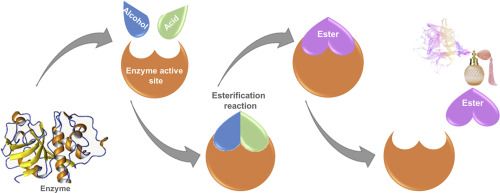当前位置:
X-MOL 学术
›
Trends Food Sci. Tech.
›
论文详情
Our official English website, www.x-mol.net, welcomes your feedback! (Note: you will need to create a separate account there.)
A review on enzymatic synthesis of aromatic esters used as flavor ingredients for food, cosmetics and pharmaceuticals industries
Trends in Food Science & Technology ( IF 15.3 ) Pub Date : 2017-09-20 , DOI: 10.1016/j.tifs.2017.09.004 Amanda Gomes Almeida SÁ , Alessandra Cristina de Meneses , Pedro Henrique Hermes de Araújo , Débora de Oliveira
中文翻译:

用于食品,化妆品和制药行业的香料成分的芳香族酯的酶法合成研究进展
更新日期:2017-09-20
Trends in Food Science & Technology ( IF 15.3 ) Pub Date : 2017-09-20 , DOI: 10.1016/j.tifs.2017.09.004 Amanda Gomes Almeida SÁ , Alessandra Cristina de Meneses , Pedro Henrique Hermes de Araújo , Débora de Oliveira

|
Background
Many sectors of industry, mainly food, cosmetics and pharmaceutics, have increased their interest in esters due to their flavor property. Flavor esters that possess an aromatic ring in their molecular structure are also known as aromatic esters. These esters are widely found in nature (fruits and plants) and the synthetic (i.e. via chemical) and natural routes (i.e. via direct extraction from nature or via biotechnology) are suitable for their biocatalysis.Scope and Approach
In this context, from the industrial point of view, enzyme-catalyzed reactions are the most economical approach to reach final green products with no toxicity and no harm to human health. The present article gives an overview of the aromatic esters synthesis, considering the main effects in the reaction media conditions and enzymes used. This review also describes applied trends in enzymatic-catalyzed reactions, pointing alternatives to production, like ultrasound-assisted reactions and process optimization of aromatic esters. Furthermore, this work presents perspectives concerning the biological potential of these esters and recent advances in their encapsulation.Key Findings and Conclusions
Lipases play an important role in the aromatic esters production, with several advantages over synthetic route. Lipase-catalyzed reactions usually follows Ping-Pong Bi-Bi or ternary complex (order Bi-Bi) mechanism. The study of the process parameters and their interaction are very important to understand the system optimization and achieve the maximum reaction yield to scale up. Aromatic esters can present some biological activities, in addition to their fragrances, which increases the interest in the encapsulation of these compounds.中文翻译:

用于食品,化妆品和制药行业的香料成分的芳香族酯的酶法合成研究进展



























 京公网安备 11010802027423号
京公网安备 11010802027423号